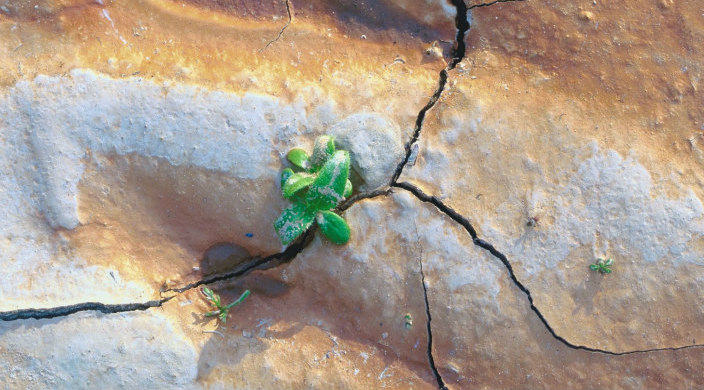
At this time of year in Israel, heat again bakes ancient stone. The land is parched, and it is easy to fall prey to fear. It can seem that the thirst of this 17th day of the month of Tammuz is not only the thirst of this year but of every summer at once. Time flattens upon itself. The stories of this day are the stories of all the 17ths of Tammuz through time.
This day, our stories say, is the day that Moses came down from the mountain. (Mishnah Taanit 4:6) Some six weeks before that day, the Israelites assembled at the foot of Mount Sinai in awe and joy at receiving the Ten Commandments. Moses then ascended the mountain, while the Israelites remained below, awaiting his return. Though their slavery in Egypt was behind them, as they waited, their hope for planting themselves in a new land slowly dried up. The summer lengthened, and Moses did not return. Fears of abandonment mounted with the temperature, and the Israelites flailed.
Finally, as we read in Parashah Ki Tisa, they gave in to their worries and the heat of their anxiety. They melted gold and made a calf. As they danced around it, Moses at last descended. Seeing them worship their idol, he smashed the tablets God had carved, then ground the Golden Calf to powder, forced the Israelites to drink it mixed in water, and ordered that those not loyal to God be put to the sword. That day was the first 17th of Tammuz of the Israelites’ journey out of Egypt: a day of grief for hopes gone awry, on their way away from the “narrow places” of Egypt.
Centuries later, the Jewish people faced a different time “in the straits.” On the 17th of Tammuz, 70 CE, the Roman army, which had been closing in on Jerusalem for months, breached the city’s walls. (Mishnah Taanit 4:6) The Jews who remained inside strove to secure the Temple Mount, the site of the Beit Ha-Mikdash, the Holy Temple, the center of Jewish worship for centuries. It was on the Temple Mount that the Jewish priests had offered daily sacrifices on behalf of the Jewish people, one of the primary ways they maintained the Covenant with God for the greater part of a thousand years.
In the Holy of Holies, the innermost chamber of the Beit Ha-Mikdash, lay the Ark of the Covenant, containing the tablets of the Ten Commandments: both the fragments of the same tablets Moses is said to have smashed at Sinai on the 17th of Tammuz centuries before and the unbroken ones that Moses made when he went up the mountain again. The Romans’ conquest of Jerusalem may have been unavoidable, but it was hastened by the fact that for months the Jewish factions inside the city had turned on each other, rather than unifying against the enemy outside the city’s walls. Three weeks after the walls were breached, the Romans took the Temple Mount on the 9th of Av, plundering the Ark, destroying the Beit Ha-Mikdash and, with it, the core worship practice of Judaism until that time. Again, because of events on the 17th of Tammuz, the Covenant was threatened, and people died by the sword.
These events on the 17th of Tammuz, and others that also have been ascribed to this date, are the reasons it has long been observed as a day of mourning in Jewish tradition. Though the day and the rituals of this time of year are not often marked by Reform Jews, traditionally, the 17th of Tammuz begins the “Three Weeks,” a period of mourning lasting until the 9th of Av (Tishah B'Av in Hebrew), the day on which the Babylonians destroyed the First Temple in 586 BCE and the Romans destroyed the Second Temple in 70 CE. The historic practice on the 17th of Tammuz itself is to observe a “minor fast” (from sunrise to sundown) and other restrictive practices, as laid out in the Talmud and later sources, for example, Kitzur Shulchan Arukh 122:1. It is a day of grief over past moments of fear and defeat. Time collapses in on itself as the Tammuz of the Golden Calf and of 70 CE are baked together, layer upon layer of time and stone.
And, yet, within this parching day, the seeds of hope also are planted, ready to sprout from the sunbaked soil.
We remember.
The Israelites’ failure in the creation of the Golden Calf ultimately led to a new understanding between God and the people: the second set of tablets was carved by Moses, not by God, acknowledging that, though the law may exist in ideal form as conceived by the Divine, in practice it belongs in the hands of those who follow it.
Torah is not in heaven, but here in our hearts. So, too, the breach of Jerusalem’s walls, tragically spurred on by senseless hatred among our own people, ultimately made room for a new Judaism in which prayer, learning, and interpretation were a mikdash (a holy dwelling) that could be passed from place to place and person to person. Torah is not beyond the sea, but here in our mouths. (Deuteronomy 30:13-14) The heat that fuses time to time on this day bakes this hope into us as well: that from our mourning can come new promise and new life, that seeds planted in parched earth await the chance to break through and bloom.
In 2022, the 17th of Tammuz will fall on Saturday, July 16. The traditional fast associated with this day will be observed on Sunday, July 17, so that observers will not fast on Shabbat.




